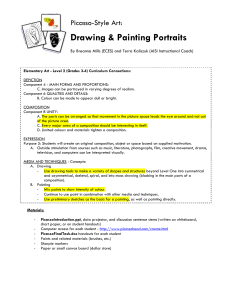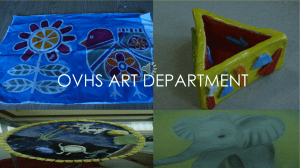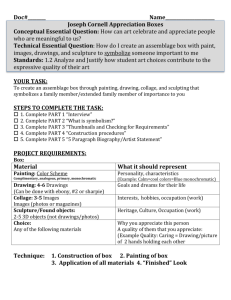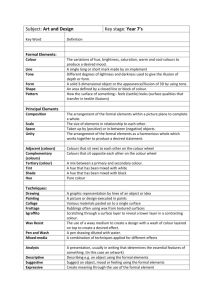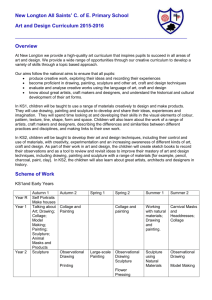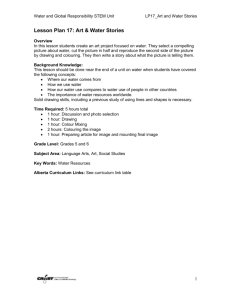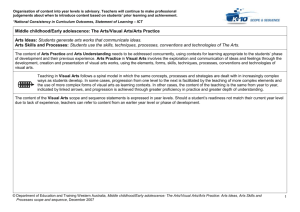hat to do in each year group
advertisement
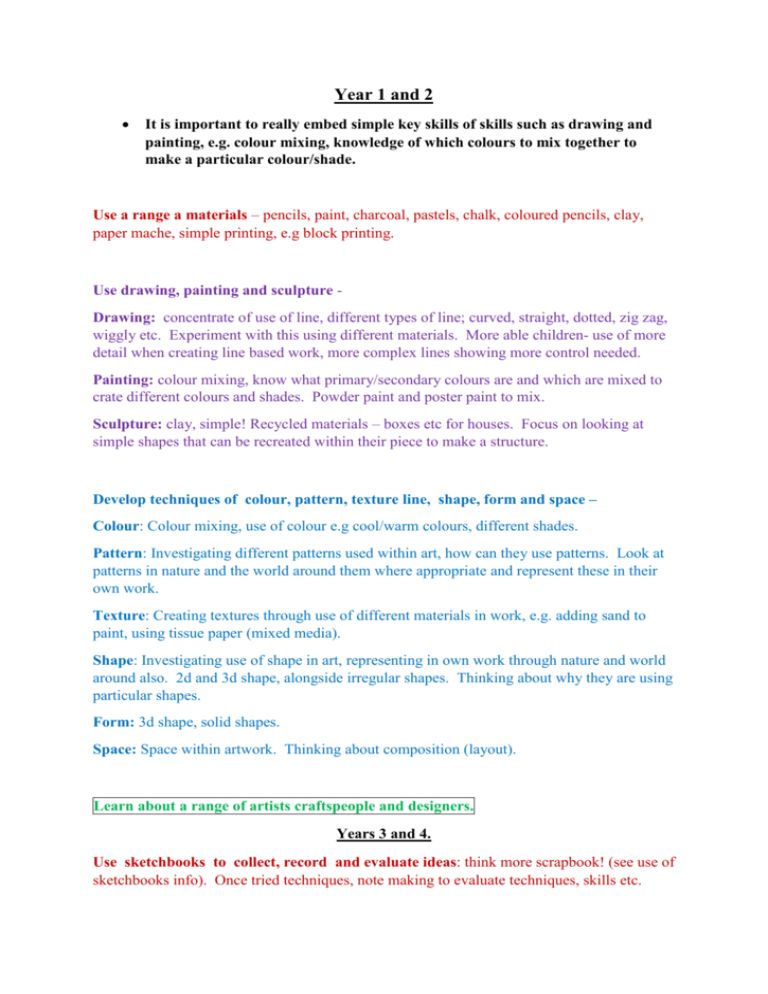
Year 1 and 2 It is important to really embed simple key skills of skills such as drawing and painting, e.g. colour mixing, knowledge of which colours to mix together to make a particular colour/shade. Use a range a materials – pencils, paint, charcoal, pastels, chalk, coloured pencils, clay, paper mache, simple printing, e.g block printing. Use drawing, painting and sculpture Drawing: concentrate of use of line, different types of line; curved, straight, dotted, zig zag, wiggly etc. Experiment with this using different materials. More able children- use of more detail when creating line based work, more complex lines showing more control needed. Painting: colour mixing, know what primary/secondary colours are and which are mixed to crate different colours and shades. Powder paint and poster paint to mix. Sculpture: clay, simple! Recycled materials – boxes etc for houses. Focus on looking at simple shapes that can be recreated within their piece to make a structure. Develop techniques of colour, pattern, texture line, shape, form and space – Colour: Colour mixing, use of colour e.g cool/warm colours, different shades. Pattern: Investigating different patterns used within art, how can they use patterns. Look at patterns in nature and the world around them where appropriate and represent these in their own work. Texture: Creating textures through use of different materials in work, e.g. adding sand to paint, using tissue paper (mixed media). Shape: Investigating use of shape in art, representing in own work through nature and world around also. 2d and 3d shape, alongside irregular shapes. Thinking about why they are using particular shapes. Form: 3d shape, solid shapes. Space: Space within artwork. Thinking about composition (layout). Learn about a range of artists craftspeople and designers. Years 3 and 4. Use sketchbooks to collect, record and evaluate ideas: think more scrapbook! (see use of sketchbooks info). Once tried techniques, note making to evaluate techniques, skills etc. Improve mastery of techniques such as drawing, painting and sculpture with varied materials: Drawing – refining drawing skills, adding more detail, looking at objects for drawing up close, 5 min drawing, 10 min, look, cover, draw etc. Painting – colour mixing – use of primary/secondary colours. Complimentary colours. Shades of colours. Choosing particular colours to represent, e.g. reds/oranges for warmth, greens for nature, blues for cold. Sculpture – clay, mod rock, recycled materials. Not just flat clay, more able children targeted to create free standing clay sculptures, e.g. fruit bowl and fruit, flowers. Varied materials – paint, drawing materials, water colours – using correctly! Fabric, thread, wool, charcoal, oil pastels, chalk, craft, printing Learn about great artists, architects & designers: Year 5 and 6. Use sketchbooks to collect, record, review, revisit & evaluate ideas: Collect images/objects from magazines, nature, internet etc. for relevant work. Record own ideas for work, reviewing these and techniques to improve on these. E.g Children try techniques using oil pastels, review and evaluate techniques, revisit and try to improve at another time. Once tried techniques, note making to evaluate techniques, skills etc. (see info on use of sketchbooks for ideas). Improve mastery of techniques such as drawing, painting and sculpture with varied materials: Drawing: refining skills of drawing – lots more detail and technical drawing. Taking note of perspectives when drawing, e.g. making something look like its further away. Painting – developing skills of watercolour painting and acrylic, gradient on work, e.g. going from light to dark within a shape. Different styles of painting, e.g. pointillism (dots) Sculpture – mod rock, clay, recycled materials, ensuring form and shape is focused on in detail. Varied materials through all techniques. paint, drawing materials, water colours – using correctly! Fabric, thread, wool, charcoal, oil pastels, chalk, craft, printing Learn about great artists, architects & designers – link to techniques, working in the style of an artist, not just recreating work, but using skills/techniques the way the artist/craftsperson/designer did.
